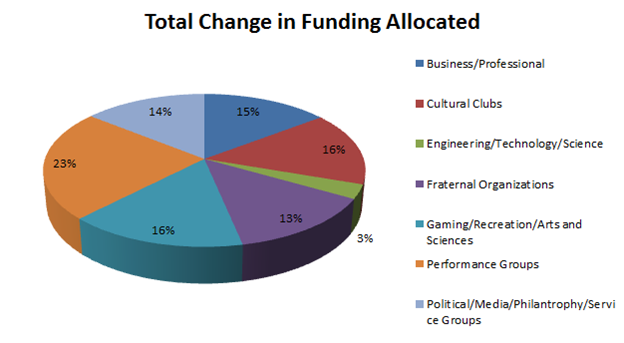Senate Allocations Decisions Part 2
April 23, 2011 in Snips
 |
 |
 |
| In part one we looked at the changes in the budget of the various groups on campus. Now we’ll examine how different classes of organizations fared. As before Centives focused on the 80 minor clubs that did not have their budgets frozen. Senate divides the minor clubs into seven major groups: |
Read more about how individual clubs fared in part one |
|
|
| There are a roughly equal number of groups in each category: | |
 |
|
| But the distribution of funds to each club is less equal: | |
 |
Engineering Clubs were the clear winners |
| The biggest winners were Engineering/Technological/Science clubs and Fraternal clubs. Both received a disproportionately larger amount of senate funds; Engineering/Technology/Science clubs, for example, received 20% of the funding while making up only 15% of the clubs. In contrast the Business and Arts & Sciences received a disproportionately smaller amount of funds with Business/Professional groups receiving 7% of the funds despite make up 16% of the clubs. | |
| The total amount of funding that each of the clubs receives depends in large part on the decisions of past student senates. Perhaps it is the enduring legacy of Engineers and Fraternities as the two things most associated with Lehigh that explains why those clubs receive such a large proportion of funds. On the other hand clubs related to the newer parts of the university, the Business department and the Arts & Sciences department, received a smaller proportion of funding. What’s more interesting is where the current senate’s priorities lie. The following graph shows that the distribution of additional funding is roughly equal, except for two categories of clubs that are clear outliers. | |
 |
There seems to be a shift in preference towards Performance Groups |
| Performance groups received 23% of the additional funds allocated, whereas Engineering/Technology/Science clubs received just 3%. There appears to be a preference for funding more esoteric types of clubs with a shift in focus away from engineering/technology/science clubs. | |
| One important caveat is that the distribution of funds and the changes in funding might not reflect the inclinations of student senate but the broad qualities of the clubs themselves. Instead of senate showing a preference for performance groups, it might be that performance groups as a whole have played a more active role on campus and have been more organized and disciplined with their budgets. This might suggest something about the types of students that Lehigh now attracts, or generational changes in what students are interested in. |



Truly difficult to find educated people about this topic, nevertheless, you be understood as you are aware of exactly what you are sharing! With thanks
[…] Student Senate Allocations Decisions Part 2 […]
[…] Student Senate Allocations Decisions Part 2 […]
[…] Senate Allocations Decisions Part 2 […]